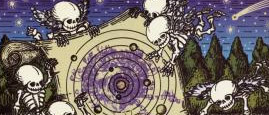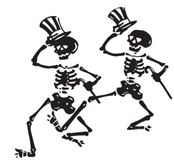By David Dodd
Here’s the plan—each week, I will blog about a different song, focusing, usually, on the lyrics, but also on some other aspects of the song, including its overall impact—a truly subjective thing. Therefore, the best part, I would hope, would not be anything in particular that I might have to say, but rather, the conversation that may happen via the comments over the course of time—and since all the posts will stay up, you can feel free to weigh in any time on any of the songs! With Grateful Dead lyrics, there’s always a new and different take on what they bring up for each listener, it seems. (I’ll consider requests for particular songs—just private message me!)
Blair Jackson once wrote a very fun piece, “The Swirl According to Carp: A Meditation on the Grateful Dead,” under the pseudonym Jack Britton, in which he characterized Grateful Dead music as “the swirl! The swirl!”
“The Eleven” epitomizes that sense of the swirl better than any other single piece. The composition, credited to Phil Lesh, rushes headlong into its eleven-beat time signature, carrying us madly along as we dance to its various combinations of meter. Sometimes I hear two fours and a three, sometimes three threes and a two…sometimes, I think I really do feel The Eleven.
And that is an almost mystical state of being, when you don’t need all those intermediary anchors, but the one comes along in just the right place each time. And the other beats aren’t pretend “ones” or twos or threes or fours, but counts one through eleven.
Live/Dead, for me, was the perfect album, which I used alongside American Beauty to demonstrate the band’s range.
When I listen to that album’s version of “The Eleven,” I always hear something new in the dense instrumentation. I can pay attention in a focused way to any one instrument, or to the interplay, or let it all wash over me.
And then, the vocals come in.
Hunter’s poem seems, if not straightforward, at least semi-coherent. But that is not the way the Dead do the song. Vocal parts and sections of the lyrics are layered, in a way that mirrors the layering of the instruments. Alex Allan, on his Grateful Dead Lyric and Song-finder site, does a fine job of attempting to transcribe the lyric as sung:
Weir & Lesh
No more time to tell how
This is the season of what
Garcia
Eight-sided whispering hallelujah hatrack
Weir & Lesh
Time of returning
Thought jewels polished and gleaming
Garcia
Six proud walkers on the jingle-bell rainbow
Weir & Lesh
Time past believing
The child has relinquished the reign
Garcia
Five men writing with fingers of gold
Weir & Lesh
Now is the test of the boomerang
Garcia
Three girls waiting in a foreign dominion
{Weir & Lesh
{Tossed in the night of redeeming
{Garcia
{Riding in the whalebelly, fade away in moonlight
Garcia
Sink beneath the waters to the coral sands below
Comparing this version to Hunter’s published words, several things become apparent.
First, the band made some changes just for the sake of available singing time. They left out the lines for seven (“Seven-faced marble eye transitory dream doll”), and four (”Four men tracking the great white sperm whale”). And the final lines of the counting rhyme are gone:
Fade away in moonlight
Sink beneath the waters
To the coral sands below
Now is the time of returning
It’s too bad, in a way, given the potential link, especially with the “moonlight” phrase, to link back to “St. Stephen” and the ladyfinger line.
But it is compact and layered. The words come at us almost as musical notes—more abstract than anything, and while we get a sense that there is some kind of profundity (“thought jewels polished and gleaming”) and counting going on, there is also the sheer profundity of the weight of the music itself, and the counting game in which we may or may not be engaged, musically, trying to figure out what the hell time signature this thing is in….oh: it’s in the title.
It’s a fun song to talk about. For instance, there is an entry in the conversation about the song on the WELL’s ”deadsongs” conference in which the author proposed that there is numerical unity between the meter and the lyrics, which, at one point, I mentioned started with eight, not with eleven. The correspondent, Joe Vanucci, wrote:
I wanted to offer the idea that perhaps there *is* unity in The Eleven. Hunter's counting starts at 8, not 11, but it could be thought of like this:
8 7 6 | 5 4 3
or
8 7 6
3 4 5
where the sums of the columns each equal 11. Like bookends. Or, as Hunter alludes "Now is the time of returning". Returning to 3, the closure for 8, if you will.
Clearly, there are many creative minds at work on this material!
Sometimes, given the fact that the band was recording Aoxomoxoa at the same time as they were performing the material on Live/Dead, I am tempted to try to create a suite of Hunter’s words, in which the repeated references to “the child” or “the baby” are of a piece. “What’s Become of the Baby?” belongs in this suite, as does “St. Stephen,” with its child wrapped in scarlet. The thematic motif extends outward, into “Friend of the Devil,” with the child that don’t look like me. And, just to take it a bit further—the lines addressing “mama” in “Brokedown Palace” seem to hint that, perhaps, the baby / child is the narrator. What’s become of the baby? Many many worlds I’ve come since I first left home.
But the band went to work on the lyrics as presented by Hunter, and once again, we are left with a fragment—intriguing, but not necessarily coherent taken on its own.
One last aspect I’d like to touch on is the role of numbers in Dead songs. For me, this comes up in a couple of ways. First is the use of non-standard time signatures, such as eleven, ten (“Playin’ in the Band”), or seven (“Estimate Prophet”) beats to the measure. These songs seemed to present no difficulty for the band, as musicians, nor for us as dancers and listeners. We just go for it, and so do they. But to me, that ease of playing in odd meters indicates a much deeper level of practice than the band is often credited with. Lesh speaks of his sense of the band as fingers, all on the same hand, and that level of cohesion is not easily achieved.
Another angle is the use of numbers in lyrics. Hunter makes fairly frequent use of numbers, as does Barlow, over the course of their writing for the band. But it never feels mystical, or numerological, to me. “Seven come eleven…” a gambling phrase, for example.
A search for the word “one,” however, comes up empty. There is no use of the word “one” in any Grateful Dead original.
So, searching for that “one.” Ah—there it comes! Nine, ten, eleven, ONE.
dead comment
WTF Samuel?
"One" More Saturday Night
It makes more sense
Let it Swirl
There’s a deeper game to play
Thank you for adding your analysis of “The Child has relinquished the reigns”
I concur and have a bit more to offer on that thread….
What if we are all one, and duality is the ultimate illusion and when the child inside each of us that has polished our thought jewels until gleaming, awakens to the moment when the boomerangs test returns ( Searchlight casting for faults in the clouds of delusion… Mirror shatters in formless reflections of matter…Lady in velvet recedes in the nights of good-bye) with the answers to our deepest inquiry.
What if the song is about that moment? A time we become willing and curious enough to live outside of believing, and an invitation to lose the illusion of self into the “night” ? Shall we go? You and I while we can? Into the swirl, the transitive nightfall of Diamond's.
After all William Tell has stretched his bow
Till it won't stretch no further Requiring a change that has yet to come.
This is the Season of what now.
The time has come
Lets keep seeking this mystery together and perhaps we will loosen our collective grips on the reigns that are driving us as a race into extinction.
I imagine in the awakening that inspired this Family and has bound the wheel together for so long.
We have much more ground to cover.
K
Flag Day '68
William Tell Bridge/The Eleven
Love the Furthur version of
Green Grow the Rushes, Ho
Alpine 2002
11-11
-One-
-One_
five men writing with fingers of gold
Re: Beginning of the Eleven
"That's It For the Other One"
That's it for the Other One
Ramble on Rose....
Dust off those rusty strings...
"One"
The Blogs...so far
Two
Yes, well...
well
Clementine short shrift
Whipping Post
12/26/81 The Eleven Jam
"one" in GD lyrics
The transition...
The Eleven Radio City Music 3/27/11
Transition to "The Eleven"
The 11 and The Seven
7/11
Speaking of gambling. When my older nephew was born on July 11 coming up on 50 years ago my brother went down to Golden Gate Field and placed bets on a horse that won. Hmmm, 40 years since my only time seeing the Dead perform the Eleven Jam. Might not have been the full Monty but it cut the muster. Or had it been Monty Python it might have cut the mustard.





Speaking of gambling. When my older nephew was born on July 11 coming up on 50 years ago my brother went down to Golden Gate Field and placed bets on a horse that won. Hmmm, 40 years since my only time seeing the Dead perform the Eleven Jam. Might not have been the full Monty but it cut the muster. Or had it been Monty Python it might have cut the mustard.